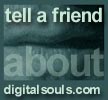|
June 2000 The
Future of Digital Art Sergey
Teterin:
How can one sell net art? H-Ray
Heine:
What I envision is a situation where collectors purchase digital art in the form of downloads, very similar to the way in which software in general is being sold. It is not difficult to develop of system of editions in which, for example, only 100 copies of an interactive work are available for purchase. Each download would have its own encrypted serial number, etc. For those art collectors who insist on something more tangible, CD-Roms and DVD will provide an alternative medium. Sergey
Teterin:
H-Ray
Heine:
Further, through the new feature of interactivity, a single work can also have an infinite number of manifestations, since the output of the work is determined by a combination of random funtions and user interactions, making it impossible to predict what the work will look like each time it is activated. One of my recent digital works - Thought Generator - combines words to create simple sentences, commands, or haiku poems, using random functions to select words and phrases from a set of word categories that each contain between 7 - 20 words, and the output is somewhat unpredictable and different for each observer who interacts with the work. In other words, there is no "original" output of the work, since this varies each time the code is called, but there is, of course, the original code or software. Similarly, the idea of an "author" looses much of its currency in digital media. A collaborative sitework on digitalsouls.com: generation/mutation v.2.1 is composed of the contributions of a large number of artists, each taking a single digital image as the starting point for their individual work and returning it with their individual modifications. The work as a whole, however, (the site), even though clearly original, does not have a single author but a collective of contributors and has become possible only through the use of the net. Sergey
Teterin:
H-Ray
Heine:
|
The Russian version of this interview can be found at: http://www.artinfo.ru/ru/news/
http://www.artpiter.spb.ru/
Sergey
Teterin
|
|
|
|
